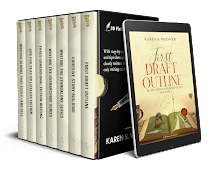Fellow-Passengers to the Grave
by Karen S. Wiesner
I've spent the last several years trying to find exactly the right word to describe a situation in which a choice by someone else is made that you don't necessarily celebrate, support, or even agree with--and yet you nevertheless go along with it in compassionate graciousness.
Like clothes I'm discarding as just not quite right, I've tried on several words that are close to the sentiment I'm striving for yet don't fully cover it. In each case, for a few minutes, I think "That must be the word I'm looking for." Then a little time passes and I realize yet another term is inadequate to describe it. Over and over, I've tossed inefficient sentiments away, and I anticipate, by the end of this article, I'll shelve another incompetent wanna-be. Here's my reasoning for turning close-but-no-cigar options aside:
Respect, these days, suggests a ladder that must be climbed. Frankly, the connotations make me squirm. It should mean "worthy of regard" and every person on the planet receives it by simple virtue of being part of the human race. Yet we've turned this term into some kind of an obstacle course in which we test the worthiness of someone and, if they're found lacking, we withhold basic human regard. Aren't equal rights a foundation that demands we learn to see every living being as worthy of respect, and therefore we don't pass judgment on their personal decisions?
Accept implies one person is in the high position of having a say in the private choices another makes. No one is and no one should. Everyone has free will, not just one. I have no right to question someone else's choices, whether to agree or disagree with them, especially if I don't want my own dissected and then ripped to shreds in endless debates as if someone is heading a "God of the Universe" committee. When it comes to someone else's beliefs, we have to have that kind of humility. Who do we think we are if I supersede other humans' judgments in how they run their own lives?
Tolerate is another term that's not quite right. With this one, there is a willingness to accept the feelings, habits, and beliefs of others that are different from our own. Unfortunately, this one has also become a bad word in terms of the negative connotations it suggests. For religious people, the word seems to demand a compromise of principles or the condoning of bad behavior, which is not at all the direction we should be going. On the other side of the coin, for some it infers, "You have to agree with me--or else." So often, "But I won't give the same courtesy" is the unspoken tagalong to such a selfish sentiment in behavior if not verbally. It's so easy for people to convey by their intolerance that their own beliefs are superior; therefore, other human beings must change to suit them or else punishment will be meted out in the form of spurning, bullying, or far worse violence. Where's the freedom in that? Don't compassion and the right to our own opinions matter anymore?
Forbear is a word I found when I went to an online dictionary and looked up synonyms of the previous words I discarded. I was impressed with this term on the whole, since it conveys patient restraint and discernment rather than harsh sentencing. Here, too, though, there's undoubtedly a bit of negativity, probably because of its connection to banking and because the phrase "long-suffering" tends to join it too often. You can almost see someone rolling their eyes, sighing loudly, and saying grudgingly, "Well, all right, I'll practice forbearance, but only if I absolutely have to." If not for that, this particular word might be one of the closest I've discovered to what I want to convey in this situation.

Recently I had a new thought on this subject (bear with me; there's a parallel coming): We human beings breathe air because we have to in order to survive. In the same way, when another person makes a decision we would almost rather they hadn't--and yet we have to live with that choice--we need to convey something like respect, genuine acceptance, tolerance, and certainly patient, restrained forbearance because we realize that our opinion is beside the point and a non-factor. Our response has to be the same as needing air to survive. It is what it is. Our feelings don't factor into other people's choices. They can't. They unequivocally don't. They shouldn't. Straightforward accommodation on our parts is the only acceptable response. This term implies displaying selfless hospitality, of seeking to meet the needs of others above our own, serving their best interests, and humbly and willingly bending like a reed if we can provide assistance to those in need around us.
But, no, once again, a word for a moment holds brilliance, then falls short in the next span of time. Accommodation also lacks perfection in conveying what I'm looking for because of the negative climate we live in. In today's world, accommodating someone else's wishes indicates having to force ourselves to do something for a dubious or moot "good cause".
Sigh. I suspect this search of mine is a lost cause because no such word actually exists. Alternately, humans may change the meaning or intention of language by popular opinion, or, bottom line, our experiences with certain words shape us emotionally for good or ill. One man's truth is another's trash. Not everyone derives the same meaning we do with words.
Nevertheless, at Christmas-time, I always think of Charles Dickens' A Christmas Carol. My search for the perfect word fits this theme. One eloquent quote for that timeless story that comes to my mind is how we're all "fellow-passengers to the grave, and not another race of creatures bound on other journeys". "Creatures bound on other journeys"--intimates that we have nothing in common with each other, no means of finding mutual understanding or the slightest reason to get along and work together. Do we actually think that way? We've all gone that route a time or two in our lifetimes, as unpleasant as it can be to admit in retrospect. But the key to integrating as fellow-passengers on this journey we call life is in the accommodation of others, mutual cooperation, and realizing we're not alone in this world. We can't live as though no one and nothing else but ourselves matters. Consider:
You do you. Allow me to do me. Let others do them.
You don't have to like everybody but do at least strive to get along.
The best way to love someone is not to judge; it's not your place.
Do to others as you want done to yourself. Yes, even if you don't get the same in return.
Pay it forward "blindly" so as not to judge the person you're trying to help--do it as an act of gratitude to those anonymous ones that gave generously in your own life.
Compromise and accommodation are often the only paths to peace.
A gift that's earned or merely a repayment of a debt isn't a gift. The best gift is that of self, bestowed magnanimously.
Anne Frank said, "No one has ever become poor by giving", but, serendipitously, many become rich by giving of themselves. This accommodation binds instead of breaks the individual as well as the whole. Let's find a way to live in peace on our journey together, fellow-passenger.
Karen Wiesner is an award-winning,
multi-genre author of over 150 titles and 16 series.
Visit her here: https://karenwiesner.weebly.com/
and https://karenwiesner.weebly.com/karens-quill-blog
Visit her publisher here: https://www.writers-exchange.com/Karen-Wiesner/















































